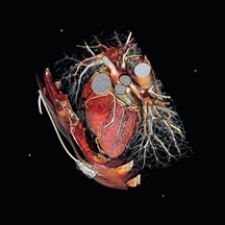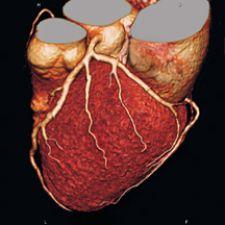
A coronary CT angiography exam performed on a Siemens' CT Somaton Definition CT.
CT scanners have evolved over the years and are showing to have applications in the emergent and non-emergent evaluation of underlying cardiovascular issues. The general acceptance for cardiovascular evaluation by CT is limited due to ongoing studies. The noninvasive nature of CT may find favor among patients and physicians if the studies prove to be an effective way of evaluating cardiovascular disease.
There have been significant advances in using CT for the evaluation of chest pain in the emergency room setting to rule out pulmonary embolism, aortic dissection or acute coronary syndrome, also referred to as the Triple Rule-Out. However, there is a distinct difference between using a 64-slice CT versus the new 128-slice CT for the evaluation of a Triple Rule-Out, according to ER physician, James Carr, M.D., from Northwestern Memorial Hospital (NMH) in Chicago.
A 64-slice CT scan has been found not to be as reliable in the Triple Rule-Out. According to Dr. Carr, “it limits the visibility of the pulmonary artery branches, (and) we end up compromising too much with the pulmonary arteries.” However, they are finding the 64-slice CT scan is useful in ruling out coronary disease and other pathologies such as aortic dissection.
Another challenge faced in the ER is the use of beta blockers, which is required by the 64-slice scanner to slow down the heart rate to get better images. Many patients who enter the ER are in urgent need of diagnosis and do not have time for the beta blockers to take effect or their heart rate is elevated due to nervousness and their heart rate cannot be controlled by the beta blockers. Carr indicates that this problem can be eliminated by using Siemens 128-slice CT scanner, a new system that is currently only available in a few ER’s across the nation. Siemens 128-slice Somatom Definition CT system uses two 83-millisecond x-ray tubes and completes a 128-slice study in 164 milliseconds—or a 64-slice study in roughly half the time. This allows cardiac CTA to be performed on patients with arrhythmia and with very fast heart rates without the need for cardiac-slowing beta-blocker medications. Therefore, regardless of the patient’s heart rate, this scan can be run. NMH plans on doing all of it’s ER cardiac imaging on the 128-slice CT and may revisit the Triple Rule-Out, using this scanner.
The 64-slice CT scanner is still useful and is in trials for outpatient use. The Toshiba CorE 64 trials are investigating replacing “invasive cardiac catheterization with CT angiography” as the primary diagnostic tool for detecting cardiovascular disease and disorders. This study contains 400 patients and is taking place in several different countries, thus creating a very diverse patient population. In an effort to gain more comprehensive results, 25 percent of the patient base are women, the same percentage that would be found in a cardiac cath lab.
By separating women out of the patient population, they can look at the number one killer of women from a more accurate view. However, since womens’ symptoms are different than mens’, the best way to begin decreasing heart disease in women is educating them about what the symptoms of a heart attack are – shortness of breath, abdominal pain, sweating, nausea, fatigue and pain in the upper back, neck and shoulders. The preliminary test results from the Toshiba Cor E 64 trials will be out by the end of the year.
As CT scanners continue to advance, so will the ability to rule out all forms of heart disease and disorders. Thus, making invasive diagnostic procedures a thing of the past and potentially providing better healthcare.


